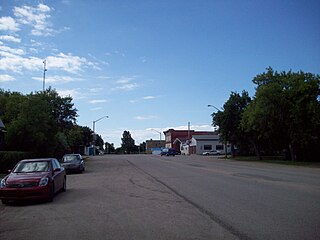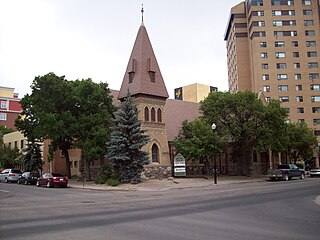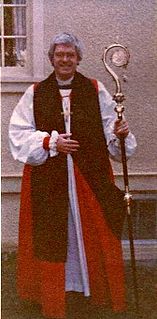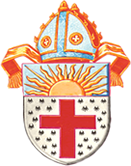Pastoral Service
Wallace's first ministry was at Fairford First Nations Mission, from 1965 to 1969, followed by St. Anne's, Winnipeg, from 1969 to 1974, both in the Diocese of Rupert's Land. [3] From 1974 to 1978 he served at Grace Church, Milton, Ontario, in the Diocese of Niagara. [4]
Wallace was known for his impish sense of humour. In 1977, when his friend Michael Peers was elected Bishop of Qu'Appelle—having become Rector and Dean in Regina and the Wallaces having attended a celebrating party—Wallace sent him a note quoting the biblical text: "Oh lord remember me when you come into your kingdom." [3] A year later, in 1978, he was appointed the Rector of St. Paul's Cathedral (Regina) and Dean of Qu'Appelle, Saskatchewan, a position he held for nineteen years until his election to the episcopacy.
Bishop of Qu'Appelle
In 1997 he was elected tenth Bishop of Qu'Appelle.
Residential Schools Settlement
The defining feature of Wallace's tenure as bishop was the residential schools litigation, which put at risk the continued existence of the Diocese of Qu'Appelle.
During the 19th and early 20th centuries, the federal government had a policy of encouraging residential schools for children of Canadian First Nations, which were administered primarily by the Roman Catholic, Anglican and United Churches. While the purpose of the schools was to assist children of First Nations to integrate in Canada, in actuality, there was a large amount of child abuse, including sexual abuse. In the 1990s, survivors of the residential schools began lawsuits against the federal government and the churches, including the Diocese of Qu'Appelle, which had been responsible for operating some residential schools.
The magnitude of the claims by the former students came near to bankrupting the Diocese of Qu'Appelle, as occurred to the former Anglican Diocese of Cariboo in the Ecclesiastical Province of British Columbia and Yukon, which ceased operations on December 31, 2001 after being forced into bankruptcy. [5] Under Wallace's leadership, the Diocese of Qu'Appelle was able to reach a settlement, as part of a national settlement made by the Anglican Church of Canada as a whole. [3] The Primate of the Anglican Church, Michael Peers, made a formal apology to the survivors of the residential schools, on behalf of the Anglican Church of Canada.
Two of Wallace's colleagues commented on the significant role he played in the settlement of the residential schools claims. Deacon Michael Jackson of St. Paul's Cathedral stated that "Duncan's inner courage and strength got us through it." Tom Morgan, Archbishop of Saskatoon, noted that "Nowhere have his skills and his non-anxious presence been more tested and appreciated than in matters concerning litigation arising from residential schools." [3]

Regina is the capital city of the Canadian province of Saskatchewan. The city is the second-largest in the province, after Saskatoon and is a commercial centre for southern Saskatchewan. As of the 2016 census, Regina had a city population of 215,106, and a Metropolitan Area population of 236,481. Statistics Canada has estimated the CMA's population to be 261,684 as of 2019. It is governed by Regina City Council. The city is surrounded by the Rural Municipality of Sherwood No. 159.

Indian Head is a town in southeast Saskatchewan, Canada, 69 kilometres (43 mi) east of Regina on the Trans-Canada Highway. It "had its beginnings in 1882 as the first settlers, mainly of Scottish origin, pushed into the area in advance of the railroad, most traveling by ox-cart from Brandon." "Indian" refers to Aboriginal Canadians. The town is known for its federally operated experimental farm and tree nursery, which has produced and distributed seedlings for shelter belts since 1901. For many years the program was run by the Prairie Farm Rehabilitation Administration (PFRA).

Fort Qu'Appelle is a town in Southern Saskatchewan, Canada located in the Qu'Appelle River valley 70 km (43 mi) northeast of Regina between Echo and Mission Lakes and not to be confused with the once-significant nearby town of Qu'Appelle. It was originally established in 1864 as a trading post operated by the Hudson's Bay Company. Fort Qu'Appelle, with its 1,919 residents in 2006, is at the junction of Highway 35, Highway 10, Highway 22, Highway 56, and Highway 215. The 1897 Hudson's Bay Company store, 1911 Grand Trunk Pacific Railway station, Fort Qu’Appelle Sanatorium, and the Treaty 4 Governance Centre in the shape of a teepee are all landmarks of this community. Additionally, the Noel Pinay sculpture of a man praying commemorates a burial ground, is a life sized statue in a park beside Segwun Avenue.

Qu'Appelle is a town in Saskatchewan, located on Highway 35 approximately 50 kilometres (31 mi) east of the provincial capital of Regina.

St Paul's Anglican Cathedral is an historic church building located on the outskirts of Regina's central business district. Built as a parish church in 1894–1895, it became the pro-cathedral of the Anglican Diocese of Qu'Appelle in southern Saskatchewan, Canada, in 1944 when pro-cathedral status was removed from St Peter's, Qu'Appelle, in the eponymous former see city which had become moribund. In 1973, when it had become clear that the once-planned grand cathedral for Regina — at the corner of Broad Street and College Avenue — was no longer a feasible project, its status was raised to that of cathedral.

Michael Geoffrey Peers was Primate of the Anglican Church of Canada from 1986 to 2004.

The Diocese of Qu'Appelle in the Anglican Church of Canada lies in the southern third of the civil province of Saskatchewan and contains within its geographical boundaries some 50% of the province's population of one million.

Many historically significant buildings in Regina, Saskatchewan were lost during the period 1945 through approximately 1970 when the urge to "modernize" overtook developers' and city planners' sense of history and heritage. The old warehouse district to the north of the old CPR tracks was Regina's original commercial raison d'être once Lieutenant-Governor Edgar Dewdney had established the site of his considerable landholdings as the Territorial Capital. With the significant conversion of shipping of commercial goods from train to truck and cancellation of passenger service on the railway, the Warehouse District immediately adjacent to the train line has ceased to be exclusively industrial in character. Some areas of the Warehouse District have been transformed into a shopping, entertainment and residential precinct.

The Roman Catholic Archdiocese of Regina is a Roman Catholic archdiocese comprising the southern part of the Canadian province of Saskatchewan, as far north as the 30th township, or about 51°30' lat, that includes the suffragan dioceses of Prince Albert and Saskatoon.

Lebret is a village in the Canadian province of Saskatchewan within the Rural Municipality of North Qu'Appelle No. 187 and Census Division No. 6. The village is situated on Mission Lake in the Qu'Appelle Valley. Lebret is located along Highway 56, about 70 km (43 mi) northeast of the City of Regina. The village was named after "the parish priest, Father Louis Lebret, who became the first postmaster of the community and, although he only held the position for a little more than six months, the office was named Lebret and the name became that of the community."
Vernon James Weisgerber is a Canadian prelate of the Roman Catholic Church. He is the retired sixth Archbishop of Winnipeg, serving from August 2000 until October 2013.
John Grisdale was an Anglican colonial bishop in the late 19th century.
Edwin Hubert Knowles was an Anglican bishop in the second quarter of the 20th century.
Eric Bays is a retired Anglican bishop.

Hugh James Pearson Allan was a Canadian Anglican bishop.
Thomas William Ralph Collings, known as Tom Collings, was a British-born Canadian Anglican bishop. He served as the seventh Bishop of Keewatin from 1991 to 1996.
Robert Hardwick is the 12th and current Bishop of the Diocese of Qu'Appelle in the Anglican Church of Canada. Originally from England, he and his family moved to Canada in 2001, where he became parish priest at St Stephen the Martyr, Swift Current, Saskatchewan. In 2008 he was appointed executive archdeacon for the diocese and in 2012 he was elected Bishop of Qu'Appelle at an electoral synod. He and his wife live in Regina, Saskatchewan, the see of the diocese.
James Settee, was of Swampy Cree descent. He was given the name James Settee when he was baptized in 1827. He was the second Native American ordained an Anglican priest; following Henry Budd. He married Sarah (Sally) Cook in 1835. He was ordained an Anglican priest and spent his career ministering to First Nations people of Canada. He was fluent in English, Cree and Ojibwe.

William Grant Cliff is Bishop of the Anglican Diocese of Brandon, in Canada. Born in 1966, in Sarnia, Ontario and raised in nearby Wyoming, Ontario.












